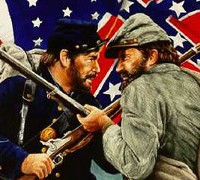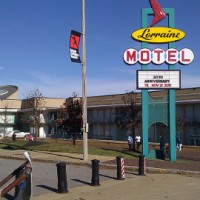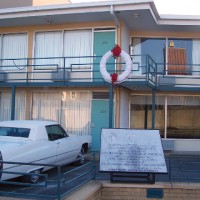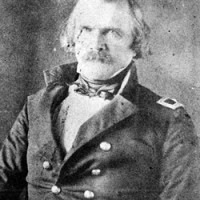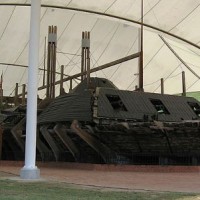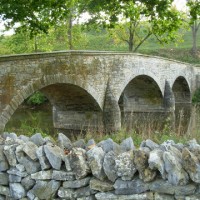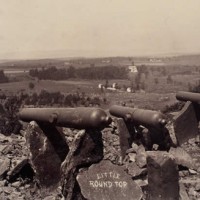A trip through civil history
- Details
- Published on Monday, 28 July 2014 17:51
- Written by Steven Bush
I love history; I should say that right away. In fact, with my MA in History earned from Western Illinois University in 2006 I have the proud title of being a historian. So it should come as no surprise that when I go on vacation, I usually stop at historical sites on the way.
Every few years I will do a longer type vacation where I have a theme and this past July I had the opportunity to do this type of vacation again.
My first stop on this vacation loop was to Memphis, Tennessee. Memphis is famous for many things from Elvis to the beginnings of rock and roll to BBQ. There is however, one more spot that tourists come to as well: the National Civil Rights Museum. Located downtown at the historical Lorraine Motel where Martin Luther King Jr. was assassinated, the museum tells the story of the African American experience with its focus on the Civil Rights Movement.
Interactive exhibits include one of the Montgomery buses from the Montgomery Bus Boycott of 1954. Here visitors can climb on the bus and if they cross a certain line the bus “driver” will tell them to go to the back of the bus or he will call the police. Another exhibit that I found of interest was being able to look into the exact room made up in the same way that Martin Luther King Jr. was in minutes before his assassination. The museum also includes the boarding house where James Earl Ray stayed, allowing visitors to look not only in his room but also in the bathroom from where he made his infamous shot.
While that was an interesting place to visit, I found that parking was a problem and I think the city of Memphis should consider opening another parking lot or building a parking garage to help as there were many people at the museum.
Sadly, parking was not a problem at my next place I visited. I love the Civil War so I decided the best place to go after Memphis was to head slightly east about two hours to Shiloh National Battlefield. Shiloh was the first major battle in the west during the Civil War and it is one of the bloodiest battles of the Civil War. Urban sprawl has not hit the area yet and because of this the federal government was able to buy much of the battlefield along with the Civil War Trust and it is well preserved.
Highlights of the battlefield included the Tennessee River, which runs along one side of the battlefield, and the Confederate Monument, which celebrates the victory the south had on April 6 and mourns the loss of April 7. Other highlights include Bloody Pond, where both sides came to drink during the battle that, since they were wounded, became red with their blood, and finally being able to stand in the exact spot where General Albert Sidney Johnson of the Confederate States Army was shot and killed on April 6.
Next, I turned southwest and drove for Vicksburg. While this was an important battlefield during the war, I would not recommend driving there from Shiloh as it was a six hour drive. Anyone who follows in my footsteps might want to go to Vicksburg first then Shiloh the day after even though that would mean going backwards.
I did have a major problem with Vicksburg National Battlefield in that there was not, to my eyes, good interpretation. The visitor drives down a road that leads past the Union lines, then over to the Confederate lines, which means that they have to really understand the battle and the siege in its entirety before visiting.
A highlight for me at the park was the remains of the USS Cairo. The USS Cairo is only one of four remaining Civil War era ironclads in existence. It was sunk by a mine in December of 1862 and discovered again in 1956. Raised in 1965 and towed to Vicksburg National Military Park, it was preserved and in 1980 was opened as an outdoor museum. The boat has a vast treasure trove of artifacts from weapons and ammunition to personal gear of the sailors who served on board her. Sadly it is the only ironclad that is still outdoors and over the years the exposure to the southern heat and humidity, bird droppings, and vandalism have hurt the ship and caused it to degrade. Perhaps in the near future funds raised for the purpose of preserving her indoors can be put to good use and she can be moved and kept for future generations.
My next major stop on my tour of Civil War-era America was Andersonville National Park. Andersonville was a major Confederate POW camp for Union soldiers. It was empty of visitors when I was there but that could be because it was the day before Independence Day. Andersonville has an excellent museum dedicated to POW life not only in the Civil War but in all wars from the American Revolution to Vietnam. The park itself is small, consisting of a replica of a stockade one can stand inside and imagine what it would have been like to be a prisoner there, to the land itself with various holes that were either wells or marked as attempts at building escape tunnels. It is a sad place but one I believe everyone should visit at some point.
After Independence Day I turned northeast and came to the realization that urban sprawl has hit the major Civil War battlefields here. My first stop was Lookout Mountain in Tennessee, which has been preserved as a small park. The park itself has beautiful views from the cliffs if one is brave enough to climb them but more tourists are interested in exploring the caves or other sights of the area.
Next I ended up in Lexington, Virginia and I highly recommend this place for everyone to visit. Lexington is a nice town and it was unfortunate that I did not have time enough to visit everything I wanted. Lexington is not only the home of the Virginia Military Institute, but it is also where General Robert E. Lee is buried, on the grounds of Washington and Lee University, and where General Thomas “Stonewall” Jackson lived and taught before the war and where he is buried.
From Lexington I drove to Harper’s Ferry National Park where the raid of John Brown took place in October of 1859. The park is the headquarters of the Appalachian Trail so there are many hikers in the park. The park preserves the original building where John Brown held off the U.S. Marines for 72 hours, although the building itself was moved after the war. It also preserves many of the fine buildings from the era. The tourist trap stuff, while there, is hidden along side streets so one is not bothered by this much.
Later that day I drove over to Antietam National Battlefield. This battlefield was the site of the bloodiest day of the Civil War and it is well preserved despite being only hours away from Washington, D.C. and the urban sprawl of the eastern coast. The battlefield takes the visitor from the start of the battle and then allows them to move south as the battle progressed.
My only complaint about this battlefield was that at one of the most important battle sites, Burnsides Bridge, the bridge was being repaired making it one way for the walkers. Since there were a lot of visitors this meant one could not really stop and just breathe in the history and quiet of a place where thousands died at one point. I personally think that while the bridge needs to be preserved, it could better be done in the fall or spring when there are fewer visitors.
My final stop of this trip was at Gettysburg National Military Park. I have been at this park before so this time was a quick drive; I was only able to hit the highlights of the battlefield because a storm blew in toward the end causing me to hurry.
The battlefield itself, of course, is extremely famous as the place where the south was turned back on its second and final invasion of the United States in July 1863. My suggestion is that one should either watch the entire Gettysburg movie that was filmed on site in 1993 or at least highlights so that they can get a sense of the battle. I also suggest paying the money not only to see the Cyclorama film but also to get a self-guided CD tour that will help the visitor by letting them know what is going on at each stop and along the way.
In the end I managed to drive 3,000 miles and I enjoyed much of this trip. I recommend anyone who is reading this to go to these sites, although you may want to try and hit only one or two at a time to better enjoy them. But you should go because these places are sacred ground; they are part of our history.
Yes, history many be ugly, but history good and bad should be taught and understood. One cannot get that from a textbook in high school; instead one needs to stand on these sites and breathe in the history.















































